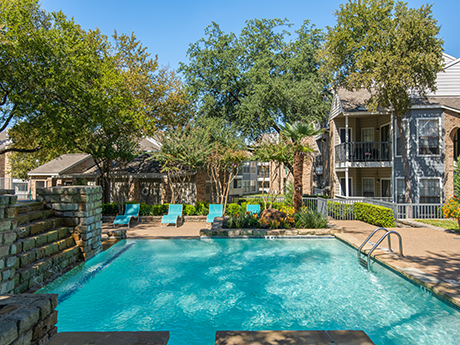Investment sales professionals are bracing for a slower, more complicated year compared with the buying and selling frenzy that characterized the Texas apartment market in late 2020 and most of 2021. Owners who acquired assets in the past few years using floating-rate debt could face some difficult choices in 2023, say industry veterans. But a slowdown in the development pipeline, the unaffordability of for-sale housing and job and population growth will keep asset performance solid while investors wait and see what the interest rate environment will bring this year.
Texas Multifamily & Affordable Housing Business emailed questionnaires to Texas-based brokers to ask for their predictions, concerns and ideas for opportunities in 2023. The participants included: John Carr and Ben Fuller, managing directors with Cushman & Wakefield, Sunbelt Multifamily Advisory Group, covering all of Texas; Todd Marix, senior managing director of investment sales at Berkadia’s Houston office; Jeff Price, managing director with Walker & Dunlop, covering Dallas-Fort Worth; Eric Stockley, vice president with Northmarq, covering North Texas; and Jack Stone, managing director of investment sales with Greysteel, covering Dallas-Fort Worth, El Paso and the greater Southwest. Their edited responses follow.
Texas Multifamily & Affordable Housing Business: What do you expect the biggest investment sales story to be in 2023? What was the biggest headline in 2022? Please explain.
Carr and Fuller: The biggest story for 2023 will focus on the alignment of seller and buyer pricing expectations, assuming there are no significant economic disruptions. In 2022, the biggest story was inflation and the Federal Reserve’s aggressive rate hikes.

Marix: The biggest headline in 2022 was identical to the biggest story we’re likely to see in 2023: When are interest rates going to stop rising? The interest rate is the metric that the market is watching most closely. Interest rates keep capital on the sidelines. Prior to the rate uptick, the biggest story in 2022 was that multifamily transaction volume was on pace to exceed the historic numbers achieved in 2021. The Houston market recorded more than $10 billion in multifamily trades last year, the second-highest year on record and ranking in the top five in the United States, according to the latest numbers from MSCI Real Capital Analytics.
Our team managed to increase our volume and market share from 2021 on the strength of our pipeline from the first half of the year.
Price: I expect that in 2023 we will see many investors consummate several acquisitions despite a higher-interest-rate environment.
Last year was a tale of two diametrically opposed markets. The first half of 2022 was a continuation of the robust transactional market that began during the latter part of 2020.
The second half of 2022 was one of acclimation to an unfamiliar environment dominated by higher interest rates and few transactions.
Stockley: Owners who have financed their communities with floating-rate debt over the past two years are going to be forced to make difficult capital decisions this year, either via refinancing, capital infusions, sales or some combination. A majority of these owners will run into this circumstance not because of property performance, but due to the debt structure and interest rate cap requirements. The 2022 headline was obviously the increase in the federal funds rate, which was the fastest that we have seen in 40 years, squeezing owners at a rapid pace.
TMAHB: Although many commercial real estate professionals were hoping for a pause in rising interest rates, the Fed indicated in December that it will continue to raise rates until inflation is significantly reduced. How will the Fed’s strategy affect the multifamily market in your territory in 2023? Have you observed a slowdown in transaction velocity?
Marix: Yes, the market is very much in a wait-and-see mode. Normally at the beginning of a new year, when capital allocations are generally at their highest, you see a wave of new product hit the market in January ahead of the NMHC annual meeting. (The 2023 National Multifamily Housing Council annual meeting took place Jan. 31 to Feb. 2 in Las Vegas.) That is not the case this year. While there are some assets coming to market, there is not near the deluge that normally occurs.
Price: Pricing and cap rates for multifamily properties, regardless of age or class, have been adversely impacted by rising interest rates. Transaction volume has slowed, with the buyer pool consisting primarily of private funds; family offices; exchange buyers or those buyers with a specific strategy unaffected by the current market, such as private family capital; or buyers adhering to affordable housing mandates. Owners who have fixed-rate loans that were originated prior to the run-up in interest rates and have a remaining term on their loans are immune to the current market conditions.
Stockley: No market has been immune to the rise since the aggressive path the Fed embarked upon in the first quarter of 2022. Where Dallas-Fort Worth stands to differ is that it has some of the strongest fundamentals in the nation in terms of job creation, population growth and a pro-business government, all of which funnels down to property-specific performance. In the Dallas-Fort Worth market, we have an occupancy rate that exceeds 96 percent. It’s true that transactions have slowed, but we have remained active by getting communities under contract and bringing new opportunities to the market.

Stone: Everyone is experiencing a slowdown, but suddenly there’s a huge demand for assumable financing. Many have put fixed, long-term debt on properties over the past couple of years at record-low rates, making those properties even more desirable.
We’re also lucky in the fact that Fannie Mae and Freddie Mac, whose mission is to provide liquidity and stability to the housing market, are the most active lenders in the multifamily sector. They currently hold close to 50 percent of all outstanding multifamily mortgages.
TMAHB: In the wake of the series of interest rate hikes by the Fed, have cap rates on property sales in your region increased? How do cap rates in your region compare with national averages?
Carr and Fuller: Cap rates on property sales have absolutely increased, anywhere from 100 to 200 basis points. Cap rates in Austin and Dallas-Fort Worth markets are generally lower than the national average given that they are both high-growth MSAs experiencing sustained investor demand.
Price: Cap rates in Dallas-Fort Worth — and in Texas broadly — have increased, but not to the level other U.S. markets are experiencing. Property performance, principally rental rate growth, remains strong. While the rental rate increases of the past 18 months are unlikely sustainable, they should remain well above historical averages. Further, with the diminishment of both single-family and multifamily construction starts, 2024 and beyond should allow multifamily owners to increase rental rates more aggressively.

Stockley: Yes, cap rates have increased in our market compared with previous years. From conversations with our other national offices and investors, cap rates in the Dallas-Fort Worth market are lower than the national average. Dallas-Fort Worth is fortunate to be buoyed by significant job and population growth, stabilizing the foundation for multifamily communities in the metroplex. In most communities, we are still seeing healthy lease trade-outs and high occupancy, leading to an attractive investment thesis for investors.
Stone: Cap rates have certainly risen since the Fed’s hikes, and buyers are less willing to be in negative leverage territory like they were over the past couple of years. That being said, Texas in general is still incredibly sought-after by investors. From a historical perspective, cap rates remain very low. We expect cap rates to adjust by 2 percent or so from their all-time high, depending on the market.
TMAHB: What trends in asset pricing have you observed over the past year?
Price: Sales prices have fallen for properties sold after the COVID highs, which started in the fall of 2020 and lasted through the second quarter of 2022. From a development perspective, certain construction costs, principally lumber, have declined. Many developers expect other cost elements to decline as the construction backlog diminishes and subcontractors seek future business.
Stockley: Asset pricing has fallen compared with the first quarter of 2022, mostly due to lending rates doubling in fewer than 12 months. The same yield profile is not as readily achievable with today’s interest rates from lenders, while modeling yesterday’s cap rates.
TMAHB: Can you assess for our readers asset performance in your region, and how does some of that data compare year-over-year or with previous quarters?
Marix: Houston’s occupancy rate ended 2022 at 90.6 percent, well above the 10-year average of 89.8 percent, according to Apartment Data Services. Meanwhile, the average effective rent per unit of $1,250 reached a new historical high as of year-end 2022, up 5.8 percent from the prior year and above the 10-year average of 4.6 percent
Stabilized, Class A occupancy is 92 percent across the market and above 90 percent for all classifications, an anomaly for the Houston market, which usually trends in the 80 percent range due to the amount of new supply that comes on line annually. However, deliveries in Houston in 2022 totaled 13,537 units compared with 20,000 and 23,000 units delivered the prior two years.
Stockley: We are still seeing strong leasing trade-outs, as high as 25 percent, on well-located, Class B communities, all while retaining high occupancy. Class A communities are seeing concessions pop up and renters less agreeable to large increases on renewals. Class C communities are still showing strong rent growth and solid occupancy. However, the performance of these communities varies by ownership and management. We have seen two adjacent Class C communities in the same area have vastly different performances.
Current units under construction comprise only 2.7 percent of total supply, in sharp contrast to other major Sun Belt markets, including Atlanta (4.2 percent), Phoenix (6.2 percent) and Austin (9.1 percent). More than 80 percent of construction currently underway in the Houston market is in the suburbs, with less than 20 percent underway in core submarkets.

Price: Property performance (occupancy, absorption, turnover and rental-rate growth) remain solid, and in many cases better than historical norms. There are certain seasonal changes you see typically in the fourth and first quarter that seem normal when compared with prior years.
Occupancy remains in the mid-90s percentage-wise, absorption for newly developed properties remains consistent, unit turnover is less than 50 percent, and rental rate growth is in the mid to high single digits.
TMAHB: Which category of buyer in your territory has been the most active over the past year? Do you anticipate any changes on that front in 2023?
Carr and Fuller: Texas buyers are a mix of private investors, REITs and international, national and local investors. We expect institutional and REIT activity will probably decline during the first half of 2023 given the nature of their portfolio allocations and valuation benchmarks.
Marix: Private capital buyers make up the majority of buyers in the Houston market, many with local ties or familiarity with the region. Investors are drawn to the yield in the Houston market, especially compared with Austin and Dallas.
Stockley: In Dallas-Fort Worth, private investors/syndicators and mid cap buyers, based both locally and nationally, have been most active recently. We anticipate institutional capital to come back into play once we have more clarity on whether the Federal Reserve will remain hawkish and for how long in 2023.
TMAHB: Are you seeing any trendlines regarding the type of apartment properties — value-add, luxury, urban high-rise, garden-style, workforce housing — that are most frequently changing hands?

Carr and Fuller: Value-add acquisitions — properties built between the early 1970s and the early 2000s — have by far been most popular. A lot of capital is chasing a value-add strategy.
Marix: Core plus, value-add and workforce housing are Houston’s bread-and-butter transactions, and that will continue this year. However, transactions in 2023 will be more need-driven versus product- or location- driven, and that goes for both acquisitions and dispositions.
Price: Those investors participating in the market seem to have a bias for suburban properties. This is a response to the declining single-family inventory coupled with families’ inability to buy homes due largely to down-payment requirements that are rising under the higher interest rates.
Stone: Value-add properties seemed to have traded hands the most over the past couple of years because these were the assets with the most upside and potential to hit various internal rate of return (IRR) targets and yields. But there are only so many value-add programs new owners can implement on the same property in a given amount of time. We’ve seen fourth and fifth generation value-adds on the same property over the course of five to 10 years.
TMAHB: Heading into 2023, what do you believe to be the biggest challenge affecting the multifamily market in your territory and why?
Marix: The biggest headwinds outside of interest rates will be insurance and property taxes for the Houston market because they will have the most potential impact on value.
Price: That’s simple — higher interest rates. Interest rates limit the debt-service-coverage ratio, thereby limiting debt proceeds. For most buyers, debt is an integral component of their capital stack and often dictates pricing for properties that they pursue. On a positive note, construction costs, land and interest rates for newly developed properties remain at a level that renders many proposed developments nonviable. The slower pipeline coupled with higher costs suggests that despite higher interest rates, investors will be able to acquire properties below current/future replacement cost. With the appropriate capital structure, investors can add to their portfolios with asset bases that stand the test of time.
Stockley: Floating-rate debt will be a big challenge, meaning assets that have increased top-line income by 40 percent are having cash flow pinched due to floating-rate-debt obligations and loan covenants. Near-term rate cap expirations are also adding another layer of unforeseen cash flow constraints. A $20 million outstanding loan balance could be looking at an approximate cap rate expense of $1 million that originally cost the borrower $75,000. There are plenty of operators that haven’t increased top-line income by 40 percent and are going to have to find a capital markets solution, or seek additional capital from investors.
Stone: Expenses are going to be the biggest challenge affecting the market over the coming years. We’re already seeing insurance costs double from where they were a few years ago, along with various other expense items. And property taxes continue to be one of the biggest hurdles in Texas. But we’ve also seen extraordinary revenue growth, which should hopefully help soften the blow.
TMAHB: Do you have any deals on the horizon for 2023 that you might be able to share with us?
Marix: There are two we are currently marketing. The Boulevard at Deer Park is a 2000-vintage, garden-style community in a high-barrier-to-entry submarket on Houston’s east side. About 86 percent of its 216 units still have white appliances, and it has limited Class A competition with only one new property under construction within eight miles.
Latitude 2976 is a newly renovated, garden-style community in highly livable West Houston. The 734-unit workforce asset has large units, averaging 1,063 square feet, including 64 townhomes. Its amenities are comparable to new construction. In this neighborhood, the average household income is $120,000.
TMAHB: Is there anything that you’d like to add or emphasize?
Marix: It is notable that three anchors of Houston’s economy — healthcare, global trade and energy — are all performing extremely well. These industries are expanding, they’re hiring and they’re attracting people to the metro. Job creation, population growth and new household formation are demand drivers for commercial real estate, and multifamily is in great shape for local fundamentals going forward.
Price: Value diminishment is only realized when a seller transacts, much like a bond portfolio with long maturities and below-market interest rates. Multifamily values historically do not ebb and flow in a long-term context, as it relates to Dallas-Fort Worth. In prior downturns/recessions, we had two additional complications: a deep construction pipeline and lackluster property performance. Neither of these elements exists today. So, if owners can sustain their properties for the foreseeable future, then their property values will be restored and they can comfortably refinance them at lower interest rates.
— Compiled by Lynn Peisner. This article originally appeared in the January/February issue of Texas Multifamily & Affordable Housing Business.

